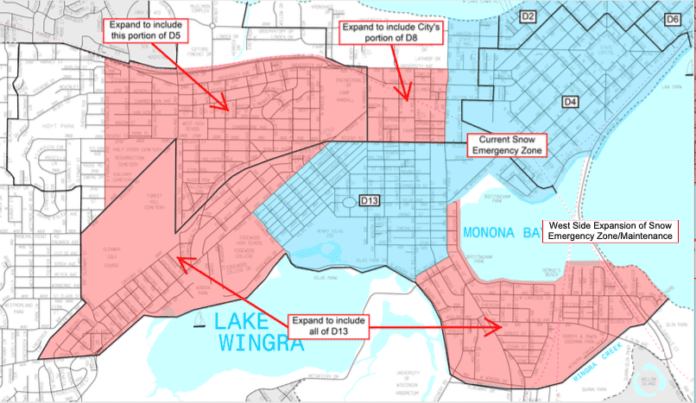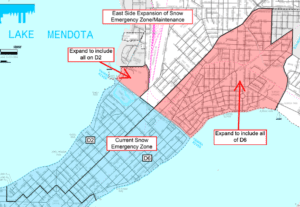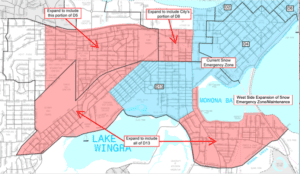Complete with maps this time! See if it affects you. Read how it will benefit the lakes and the city.
EAST SIDE EXPANSION
2019 East Expansion of SEZ pdf
WEST SIDE EXPANSION
2019 West Expansion of SEZ pdf
HOW THIS IMPACTS DISTRICTS 2 (Zellers), 4 (Verveer), 6 (Rummel), 8 (Woods) & 13 (Eskrich/Arntsen)
The map shows what is currently exempt and will be brought in to following these rules.
SnowEmergencyExemption_by_AlderDist
Bottom line up front:
This proposal has three parts: 1) Expand the Snow Emergency Zone (SEZ), if you currently live outside of the SEZ you may want to read the entire document 2) Make all streets within the SEZ year round maintenance\ CSCL, if you live in the SEZ but your street is not a year round CSCL you will want to especially read the benefits of having this year round 3) Eliminate the exemption for one side parking only streets from following SEZ parking rules. While its understandable this will bring concerns about parking its typically only a handful of nights per winter and you’ve likely seen the problems as the snow compacts and freezes down in these areas and the cars park ever more out in traffic and in some cases bike lanes. You’ll especially want to read towards the end of this document.
Proposed Year-round Clean Streets/Clean Lakes & Snow Emergency Zone Rule Changes
If you’ve been dealing with Alternate Side parking, winter parking in your neighborhood is about to get easier and your roads will be cleaner, too.
The snow emergency zone is expanding again and looking to include your neighborhood. Additionally, your streets would be added to the year-round Clean Streets/Clean Lakes program.
This means that instead of the nightly winter shuffle to find a legal parking spot along the street for the overnight hours, there will only be a once per week four-hour block of time between 8a-4p where cars cannot park along the street. Alternate side parking rules would only be enforced during the few declared snow emergencies we have in a winter season.
Since year round CSCL means vehicles will be moved off the street regularly throughout the year, the street will be cleaner and snow plowing and other services will improve.
What is Clean Streets/Clean Lakes?
The Clean Streets/Clean Lakes (CSCL) program prohibits parking during a four hour block of time between 8:00 a.m. and 4:00 p.m. on a single weekday. We do our best to designate different days for opposite sides of the street so parking is still available.
What is “alternate side parking”?
Alternate side parking means that on odd-numbered dates, residents must park on the odd house numbered side of the street. On even numbered days cars must park on the even numbered side of the street. These rules are in effect nightly regardless of weather from 1:00 a.m. to 7:00 a.m. Nov 15 th through March 15 th for everyone not within a Snow Emergency Zone.
What is the Snow Emergency Zone?
The Snow Emergency Zone is a designated area of Madison that only follows alternate side parking rules during a declared snow emergency and is typically characterized by neighborhoods with narrower streets and or limited parking options.
How does prohibiting parking make for cleaner streets and lakes?
Road debris contains salt, sand, leaves and other harmful substances that leak from cars and it all accumulates in our street gutters which often lead directly to our lakes. When cars park on the street they prevent street sweepers from collecting what is lying in the gutter. Moving the cars means the debris can be picked up efficiently and kept from our waterways.
How does year-round enforcement of CSCL help other services?
There are many city operations that can be improved by year-round CSCL enforcement.
Snow Plowing
As snow piles up along the curb, parked cars begin to creep away from the road edge and into the travel lanes, making for narrow streets and blocked bike lanes.
The simplest way to prevent the parking creep and keep streets wide and safe for all road users, including emergency vehicles, is to push the snow all the way to the terrace. However, parked cars block snow plows from pushing snow that’s along the curb.
Following the once per week CSCL four-hour parking restrictions in the winter can decrease the need to declare snow emergencies. Snow emergencies are designed to force parkers to move their vehicles so the roads can be plowed wide and safe. If the roads can be kept wide and safe throughout the season, then it lessens the need to ticket and tow people overnight or initiate the cumbersome and confusing daytime 48 hour temporary post and tow process as streets become too narrow to provide safe passage of emergency vehicles, refuse collection and in the worst cases even passenger vehicles.
Spring Cleanup Street Sweeping
Following winter, the Streets Division has street sweepers work 16 hour days in order to collect all of the sand, salt, and road debris that accumulated on the roads during the winter. The spring cleanup process usually begins in mid-to-late March, depending on the weather conditions.
Year-round CSCL enforcement allows street sweepers access to the curb as soon as the weather allows sweeping to begin, often 4-6 weeks earlier than only seasonal CSCL streets. This will result in collecting more road debris before spring rains wash it into the storm drains and into our waterways.
Brush & Leaf Collection
Brush and leaf collection crews rotate through the city collecting the material set out to the curb. When cars park in front of the piles of brush or yard waste, which happens regularly, it results in a slower and less complete collection. Year-round CSCL allows a possible solution to this problem.
In 2019, two areas within the year-round CSCL will pilot an effort to collect leaves only during those neighborhood’s parking restrictions. This will allow easy access to the curb, which should allow for faster and more efficient service while also allowing residents to know exactly when leaf collection will occur.
Terrace Tree Maintenance & Stump Removal
Madison’s street or terrace trees, are maintained by City Forestry crews. They too encounter challenges related to vehicles parked on the street as they interfere with pruning, removal and planting operations. Streets Division crews remove stumps after a tree has been cut down, and parked vehicles can prevent that work from being performed.
The once weekly CSCL four-hour block of time prohibiting parking allows the curbside access needed to more efficiently prune, remove, stump grub and replant our City’s urban forest.
If I already live in the Snow Emergency Zone, will these proposed changes affect me?
Possibly.
There are two proposed changes to existing rules (explained below) that may change your on-street winter parking plan.
Proposed Rule change: All Streets within the Snow Emergency Zone will now be added to
year-round Clean Streets/Clean Lakes maintenance program.
All streets within the snow emergency zone will now have year-round Clean Streets/Clean Lakes parking enforcement. Before, certain streets only needed to follow CSCL restrictions from May to November and these spots within the Snow Emergency Zone will be switched to year-round enforcement.
Proposed Rule change: Streets within the Snow Emergency Zone with legal parking only on
one-side would now abide by alternate side parking during declared snow emergencies.
One persistent winter maintenance challenge are streets that have parking only on one side. These are prize parking locations in the winter since these areas currently don’t need to abide by alternate side parking rules even during declared snow emergencies. This also means they are routinely full of cars and unable to be plowed completely.
Historically, these one-side parking streets are among the worst for winter maintenance because the vehicles simply do not move to facilitate plowing. As a result, these streets experience the same dangerous narrowing as other streets – snow builds up and parkers creep into the car and bike lanes.
In an effort to address this problem and have these streets better plowed to make the roads and lanes safer, they would now be required to follow alternate side parking rules during declared snow emergencies only.
During declared snow emergencies, parking will remain prohibited on the side where legal parking has already been restricted. Parkers must find a parking spot on another street or be subject to ticketing and towing.








